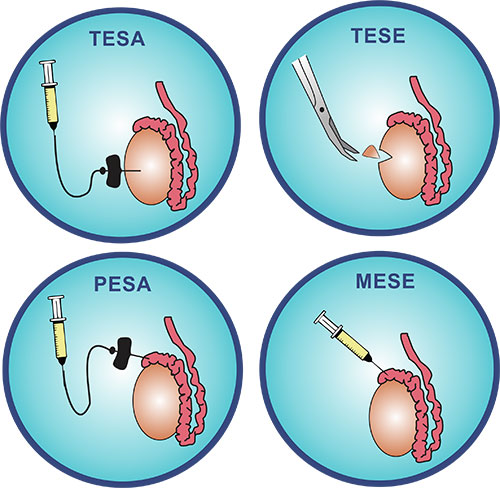What is TESA and PESA?
As mentioned, TESA stands for Testicular Sperm Aspiration. This is an assistive reproductive procedure that involves the retrieval of testicular tissue through a needle attached to a syringe and injected through the skin on the man’s scrotum. TESA is usually a little more complex as compared to PESA and is performed if there is no sperm found within the epididymis, thus prompting for a needle to be inserted directly into the testicles.
PESA, which stands for Percutaneous Epididymal Sperm Aspiration, is a less complex sperm extraction procedure as compared to TESA. It involves insertion of a needle into the man’s epididymis, the tube that connects to the testicles, for sperm retrieval.
CONTACT US
When is TESA and PESA carried out?
TESA and PESA are usually carried out when a man’s ability to naturally release sperm via ejaculation is reduced by blockage of the vas deferens or epididymis. Though, PESA involves collecting sperm via a small needle that is inserted into the epididymis while TESA involves collecting sperm via a small needle that is injected directly into the testicles. Some of the conditions that may require TESA and PESA to be performed are discussed below.
Azoospermia
This is a condition where the man’s ejaculate contains no sperm, accounting for between 10% and 15% of the causes of male infertility. This could be as a result of blockage in the sperm delivery system or reduction in the amount of sperm produced in the testes. Whether a man is suffering from obstructive or non-obstructive azoospermia, sperm can be retrieved using PESA or TESA depending on its severity.
Testicular Failure
Due to chromosomal abnormalities caused by conditions such as Klinefelter’s syndrome or other abnormalities of the Y chromosome, a man may experience testicular failure. This disorder reduced the ability of the testicles to produce and store enough sperm that can make their way into the woman’s uterus during ejaculation.
Varicocele
This condition is characterized by benign testicular cysts that may arise from a mass of varicose veins forming within the spermatic cord or epididymis. This may cause blockages that will definitely affect the flow of sperm out of the testicles and epididymis. To retrieve sperm from a man suffering from this condition, then TESA or PESA will work best.
TESA
If after all the PESA procedures have been performed and no sperm is present in the vas deferens or epididymis, then TESA is performed. A small needle will be injected directly through the testes, into the testicles and testicular tissue aspirated by having the plunger drawn out. Just like in PESA, sufficient quality and quantity of sperm should also be retrieved using TESA. PESA and TESA are a great option for couples, much better than Intrauterine Insemination using donor sperm as it also gives the man the golden chance to contribute to their offspring’s genetic structure.
Benefits of TESA and PESA
Most men who suffer from infertility usually assume that they are completely sterile and they can never impregnate a woman. What most of them forget is that there could be a condition preventing sperms from getting out of their reproductive system during ejaculation. PESA and TESA will determine exactly where the issue is and solve it by retrieving sperm from the epididymis or testicles via a thin needle. While it may be a little painful, it will make it possible for a man to get their woman pregnant through In Vitro Fertilization.

Steps Involved in TESA and PESA
Administration of Anesthesia
PESA is usually performed under local anesthesia which involves the anesthetic being injected directly into the scrotum. This is meant to make the area numb thus preventing pain during the whole procedure.
Extraction of Sperm
Once the vas deferens has been located, a small needle will then be inserted into the vas deferens or epididymis and the plunger drawn out for the seminal fluid to be aspirated into the syringe.
Examination of the Testes
The doctor then swabs the scrotum using warm antiseptic to disinfect the area before the procedure. The testes are then examined by feeling the scrotum to locate the vas deferens.
Inspection for Motile Sperm
The retrieved seminal fluid is then examined for moving or motile sperm by an embryologist. If the sperms aren’t adequate, then PESA will be repeated until enough is found.
